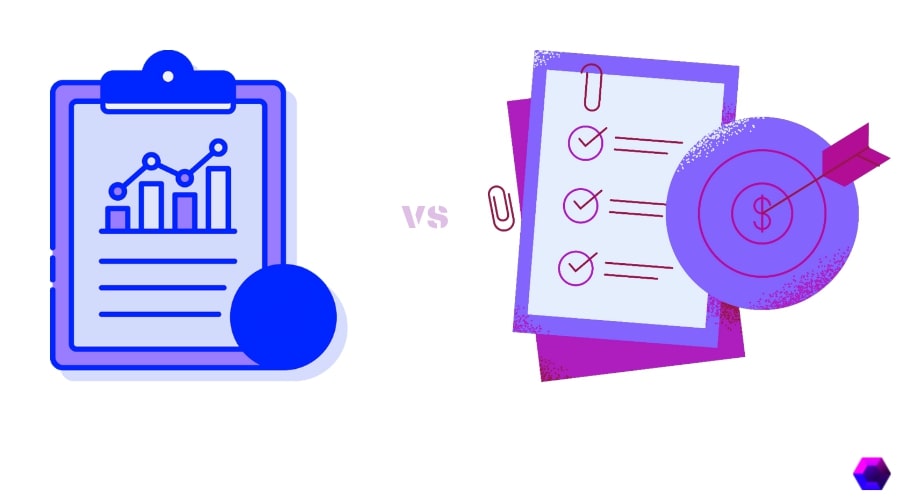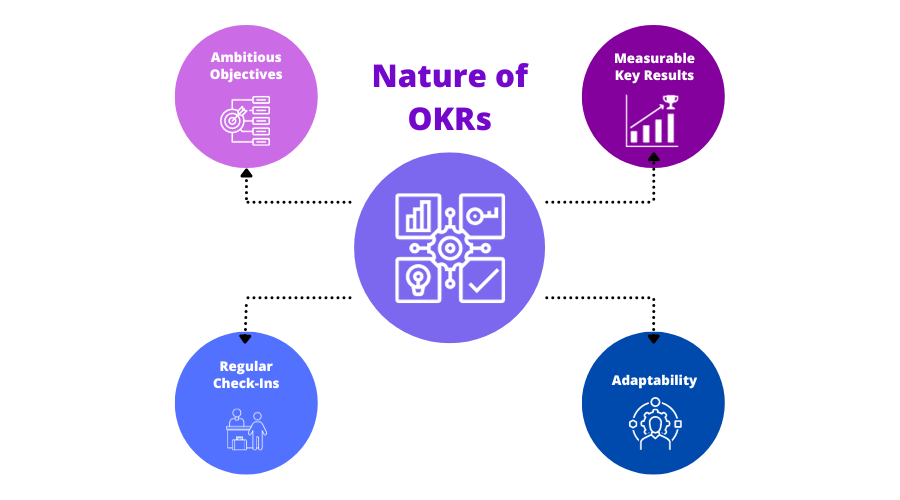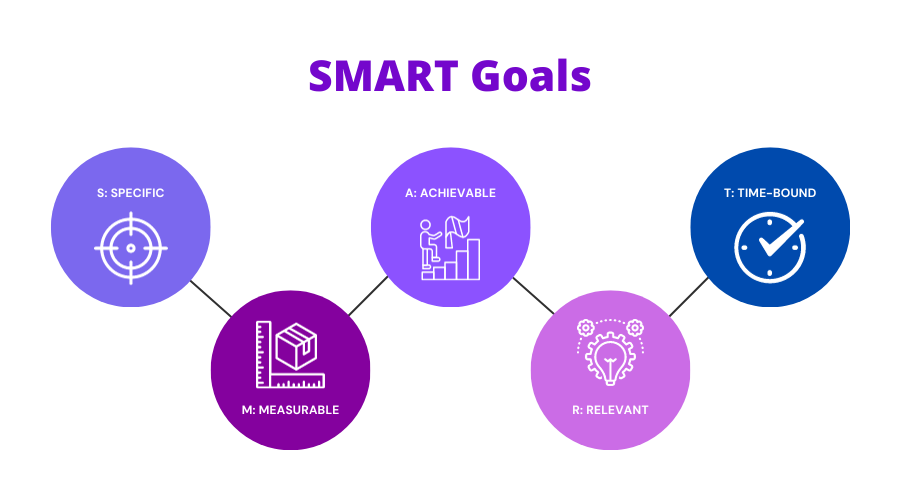OKRs vs. SMART Goals: Which One Should You Use?

Life is nothing but a series of decisions after decisions. Each decision leads up to the goal we’ve set for ourselves.
Unlike life goals, you can’t make organizational goals based on personal preference on choice. Your company goals aren’t just another “I will be rich one day.”
While chasing your company’s or product’s vision, you have to make serious and achievable goals. And recently, two types of goal-setting frameworks are in the buzz.
One is Objectives and Key Results (OKRs). The other is SMART goals.
Companies are employing them in their day-to-day management and decision-making.
As a product manager, you will often find yourself at crossroads between the two. Should I use OKRs to define my team’s goals, or should I set SMART goals?
You wouldn’t ask yourself questions like such if you had a clearer picture of the difference between OKRs and SMART goals.
While both OKRs and SMART goals help organizations with their goals and objectives, they are not identical.
In this post, let’s understand the difference between OKRs and SMART goals and how each one helps. In the end, you will be able to choose which one’s best for you.
Read till the end to get a bonus product management tool to help your goal-setting!
Let’s begin.
What Are OKRs?
The acronym OKRs stands for Objectives and Key Results. It is a goal-setting and management framework. OKRs have two critical areas, as evident from the term- objectives and results.
Andrew Grove from Intel was the brains behind the OKR framework. However, Google later popularized its use.
OKRs guide goal management by defining the big picture objectives and laying out the measurable results that indicate its achievement.
The objectives in OKR represent what you want to achieve, and it defines your goal. One usually does this at the company level but at more minor levels.
The key results specify the measurable metrics that indicate the achievement of your objectives. They usually imply tasks for your departments and teams.
The key results are the part of OKRs that align company objectives to team and individual goals.

For Example
Here’s an OKR for a food delivery app. Suppose the app is relatively new. Your more giant objective is to increase brand awareness.
But you want to push the digital marketing team to its full potential to achieve this.
In such a case, one of your OKRs would look like this-
Objective: Increase brand awareness.
Key Result: Gain 5,000 new social media followers in 30 days.
That gives us a gist of what OKRs mean. A pretty simple yet powerful tool, right? Now, let’s look at SMART goals.
What Are SMART Goals?
SMART stands for Specific, Measurable, Attainable, Relevant, and Time-Bound Goals. The framework suggests that any goal you set must pass the five criteria.
George Doran first coined the term SMART in his write-up called ‘There’s a SMART Way to Write Management’s Goals and Objectives.’
SMART goals ensure we’re not just dreaming but have our feet on the ground.
The 19th-century philosopher Hubbard put forward a similar concept. He explained that failed goals result from inefficient goal setting rather than poor intellect.
Let’s see what the five criteria of SMART goals mean.
Specific
This means that your goal or objective needs to be particular and defined rather than vague. The more specific you are about your plan, the more efficient it is.
Being specific requires one to describe and state the goal clearly.
For example, if you want to add new features to your product, a specific goal and non-specific goal would look like this-
Non-specific: Add new features.
Specific: Deliver new features in the user interface.
See how we specified where the feature would be exactly? Let’s make this goal smarter now.
Measurable
This criterion requires your goal to be ‘measurable.’ You have to finalize a metric or quantifiable indicator of your achievement.
A student may have a goal of scoring well on their SATs. But they need to define what ‘well’ means for them. Perhaps it could be scoring at least 1400 out of 1600.
Similarly, when you chalk out your goals, you have you also outline how you would measure them.
Let’s elaborate on our previous example.
When you add a measurable element to your goal, it would sound something like this-
Measurable: Deliver four new features in the user interface.
Do you see how we have now made our goal quantifiable? This helps us measure our success. Delivering four features now becomes your baseline objective.
Attainable
Now, this is a criterion of SMART goals that people usually neglect. But it carries heavyweight.
While setting goals for your team, you have to consider whether it is achievable. Examining your team’s capacity is very important.
You may have high aspirations about your project, product, or company. But ultimately, it is your team that works towards it.
When you set impractical or unattainable goals, you set yourself up for failure. This further affects your members’ morale and productivity.
For example, suppose delivering four features would be ideal. But your team is small and may not have the time or resources on hand.
Gauging their capacity, you could alter your goal as follows-
Attainable: Deliver two new features in the user interface.
Relevant
This criterion sets you apart from a goal-hoarder. You can decide all kinds of objectives, but they won’t be productive if they are irrelevant.
Your goals need to be relevant. Relevant to the current project, company goals, and your market.
For example, let’s take our example about delivering features. The goal started with user and market research. The company identified gaps in the user experience. Thus, it was necessary to improve.
This makes our goal relevant. Relevancy aligns team goals with company goals. This way, members know their contribution to the big picture.
Time-Bound
And finally, you want your goal to be time-bound. This seems pretty obvious. But more often than not, people ignore it.
The purpose of setting a goal is to achieve it. And we want to achieve it within a specific period. This ensures efficiency and product excellence.
For example, our user interface example would be completely SMART if we added the duration to it.
Here’s what it could look like-
Time-Bound: Deliver two new features in the user interface within 60 days.

Now we have a clear picture of OKRs and SMART goals. Let’s first understand how they are similar before getting into the differences.
The Similarities Between OKRs and Smart Goals
Both OKRs and SMART goals are popular performance management and goal-setting tools.
However, despite their differences, they do have some similarities.
It is essential to understand these similarities before we get into the differences. The parallels between OKRs and SMART goals may be why most product managers get confused.
Here Are the Fundamental Similarities Between Okrs and Smart Goals-
- Both OKRs and SMART goals focus on efficient goal-setting.
- They provide structure to your decision-making.
- They emphasize specificity rather than vagueness in objectives.
- They are practical and measurable. They emphasize observable results.
- Both OKRs and SMART goals are flexible models that can evolve as per your needs.
For example, OKRs can change as per the situation in your company. And the acronyms in SMART can be altered as per your needs. For instance, sometimes product managers prefer ‘simple’ instead of ‘specific.’
Well, those are the fundamental similarities between OKRS and SMART goals.
After getting our basics right, let’s delve into the difference between OKRs and SMART goals. This will help you make better decisions.
Difference Between OKRs and Smart Goals
Both OKRs and SMART goals are performance management tools that focus on setting measurable goals and tracking progress.
However, there are some critical differences between the two.
The Differences Between OKRs and Smart Goals Are as Follows-
Evolution
The 20th century introduced SMART goals. George T. Doran coined the acronym in an article called ‘There’s a SMART Way to Write Management’s Goals and Objectives.’
However, the general concept dates back to Elbert Hubbard, a 19th-century philosopher. He claimed that people who failed in their pursuits were not putting out enough effort.
Rather than lacking intelligence, courage, or devotion, they failed to achieve their objectives.
In contrast, Peter Drucker proposed the Management By Objectives (MBO) paradigm decades ago. By today’s standards, it’s pretty old.
OKRs, on the other hand, are a modern update on Drucker’s ideas. His goal was to keep managers from falling into an ‘activity trap.’
This is because failing to assign would cause them to lose sight of their company’s larger goals.
Although some experts believe Drucker’s method was incorrect, it set the foundation for the more polished OKR model we know today.
Usage
Organizations typically use OKRs (Objectives and Key Results) to measure their overall performance.
SMART goals, on the other hand, measure individual or team performance.
Scope
OKRs are typically more broad and overarching, while SMART goals are more specific and actionable.
OKRs decide on big-picture objectives and key results. On the other hand, SMART goals narrow down that big picture into smaller actionable tasks.
Duration
OKRs are typically reviewed and updated quarterly, while SMART goals should be reviewed and updated monthly or weekly.
Since OKRs have a broader scope, updating them at shorter intervals is not feasible.
Thus, OKRs are more suitable for developing long-term goals, while SMART goals work for the short-term.
Goals and Results
Now, OKRs focus on both the goal and the means to achieve it. However, as evident by the term, SMART goals only focus on goal-setting.
Therefore, SMART goals may be one-sided as they emphasize the objectives but not the methods.
Adaptability
SMART goals are more adaptable than OKRs. This is because OKRs use a top-down approach. The objectives move from company level to personal.
Each individual or team is contributing to a common objective. Thus, the involvement of many people makes it difficult to alter OKRs anytime.
On the other hand, SMART goals are at an individual or team level, and you can easily alter them as per the required results.
Alignment
OKRs align the organizational goals to individual goals. The vision and objectives are apparent across the company. However, SMART goals are more personal and achieved in isolation.
This is why OKRs are used on a company level for bigger goals. But SMART goals are better for sub-goals.
If you look at it, SMART goals are a sub-set of OKRs. You can use them to set objectives and results in a SMART way.
However, OKRs are a broader framework to set your vision and the observable results to achieve them.
So, now that we know so much about OKRs and SMART goals, what should you opt for? Let’s understand that.
OKRs vs. Smart Goals: Which One Should You Choose?
If you’ve understood how OKRs and SMART goals differ, the choice becomes pretty clear.
It’s not a this-or-that situation. You can simultaneously employ both OKRs and SMART goals. However, it would help if you thought about where you will utilize each method.
There’s no hard or fast rule to using these frameworks. Although, in our experience, we have seen the following results.
It Is Wiser To Use OKRs When-
- You want to cultivate cross-functional team alignment.
- You want to make each employee aware of their contribution to the big picture.
- Bigger company goals need company-wide action.
- You wish to foster organizational engagement.
- You want to achieve objectives less rigidly and more creatively.
And now, onto SMART goals.
It Is Wiser To Use SMART Goals When-
- You want to encourage employee independence.
- You wish for employees’ personal development.
- You want to boost individual and team productivity.
- You want to narrow down your OKRs into actionable tasks for teams.
- You want to track individual performance.
The critical difference is that OKRs apply to a broader context. At the same time, SMART goals are isolated, and you can then utilize them as per your need.
Using product management tools such as kanban boards helps facilitate the achievement of your SMART goals.
If you’re new to product management software and don’t know which to pick, here’s an all-in-one free platform!
Start your free Chisel trial today and keep track of your OKRs and SMART goals efficiently.
Don’t forget to visit our blog for more information on product manager tools!
